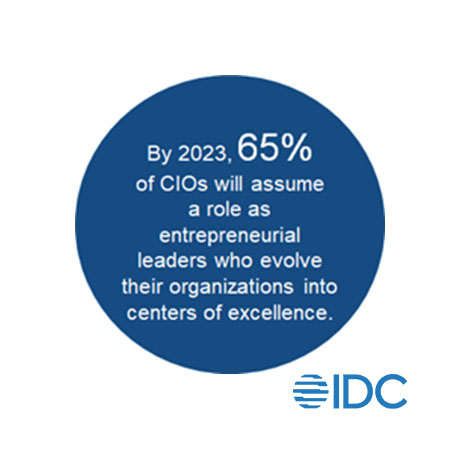As we reflect on the many changes wrought over the past two years, one will be that we have transitioned from discussing “digital transformation” to the active embrace of digital-first business and technology strategies — technology underpins the business model of the future. Further, this new digital-first business model includes the Future CIO as a member of its leadership team as it strives to deliver the transformational capabilities, services, and products the business needs to meet this new imperative.
The Future CIO must go beyond their usual focus on operational efficiency – they need to help the business cope with macro challenges like geopolitical instability, new supply and energy disruptions, and significant economic uncertainty. They will also be critical execution leaders as lines of business and operational teams struggle with micro challenges like changing client expectations and significant price instability in raw materials and labor.
This Future CIO blog offers three actionable steps for digital leaders to consider as they tune their organizations for the balance of 2022 and into 2023 amidst the geopolitical, economic, and social volatility being experienced worldwide.
Embody a Strategic IT Leadership Model
The first crucial step is to embody a leadership model that aligns with the business on priorities for transformation. Strategic connections support collaboration and organizational communication toward a unified sense of purpose for both IT priorities and overall business strategy. Strategic technology then supports the business’ ability to handle volatility. The new strategic partnerships include collaboration on IT financial management, supporting responsive strategies that address market factors and are holistic for the business rather than just focused on cost, and extend beyond the traditional budget and service measures that often govern IT spending.
Collaborative partnerships replace traditional support models by building business engagement and enabling commitment-based communication. Transformational success depends more than ever on effective CIO communication into and at all levels of the organization.
“Communication can’t be a PowerPoint or an email; it has to be a continuous and consistent push to communicate to the organization and to the company.”
Peter Weis, CIO, Matson
A strategic IT leadership model reaches beyond technology — it enables genuine communication and collaboration. Strategic leadership gives strength to others across the organization, so all stakeholders participate in the “what’s next” dialogue. Future CIOs must have their feet firmly planted on the ground to withstand the winds and deliver that “next” value.
Know and Embrace Your Highest Value to the Organization
More than ever, the CIO’s highest value will be their ability to look at the integrated business and IT portfolio and make the tough decisions. Digital leaders will continue to be asked to do more with less, but there is an unprecedented opportunity to give the business cause to pause. Post-pandemic business reassessments create the ideal inflection point for IT to successfully recalibrate their road map and bring forward difficult conversations.
Use this opportunity to do three things:
- Freeze low-value projects that are consuming resources and distracting the team. Lead with the business to assess every initiative and clearly prioritize projects that best accelerate business goals. Identify opportunities to leverage existing digital ecosystems to quickly acquire capabilities without having to build them. Have the difficult conversations about what is unique to the business model and only fund “special snowflakes” if they are truly critical and unique.
- Dig even deeper to make the hard decisions inside the technology road map to align technology investments with the “next” business priorities. Be ruthless to call out a zombie project if you find one and focus on shorter-term deliverables with the highest strategic value. Look for 90- to 120-day paybacks for opportunities to be more impactful to digital strategies.
- Recognize that IT will continue to be asked to do the impossible. Often the only way that can be done is by incurring technical debt. Make investment strategy and trade-offs an explicit conversation with IT and business colleagues.
The highest value the Future CIO will bring to their organization is to continuously recalibrate the investment road map to deliver the right things, in the right order, at the right time.
Recognize, Now More than Ever, the Human Element
As organizations adapt to these turbulent times, Future CIOs are challenged to deliver improved experiences for all stakeholders including customers, employees, and suppliers. Actively engage the team to gather and discuss perspectives from both inside and outside the organization, building the entrepreneurial skills that will ensure engagement and support retention of critical IT skills.

The Future CIO will extract every ounce of performance from their IT organization, and skilled entrepreneurial teams will be the Future CIO’s highest-leverage tool for the future.
We are in a digital-first age. The leadership opportunity for CIOs is to differentiate their contributions by channeling enough positive energy to power the whole team. It may require letting go of some things and embracing other things. Choose to focus on the art of the possible. To learn more about how digital leaders can step into the role of Future CIO and lead the transformation agenda, register for the upcoming webinar, live on June 22nd at 1 PM/ET. Click the button below to register.




